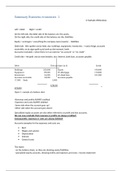Resume
Summary: Basics of financial management (business economics 1)
- Cours
- Établissement
Information summary (without exercises) of the book Basics of Financial Management. The summary includes chapters 1,2 & 5. It contains all information needed to pass business economics 1.
[Montrer plus]



